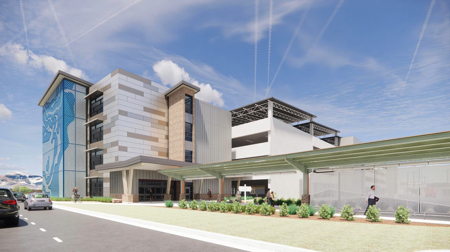
Reno-Tahoe International Airport Ground Transportation Center including a Consolidated Rental Car Facility
Conrac Solutions and Meridiam
In partnership with the rental car industry (RACs) and the Reno-Tahoe Airport Authority (RTAA), Conrac Solutions and Meridiam reached Financial Close to develop, finance, and operate a Ground Transportation Center (GTC) and Consolidated Rental Car Facility (ConRAC) at the Reno-Tahoe International Airport in May 2024. The $299 million project – the first following Meridiam’s acquisition of Conrac Solutions in May 2023 - is privately financed by Meridiam, a global infrastructure developer and asset manager. The project is part of the Airport's broader MoreRNO multi-year infrastructure program. Meridiam developed the project in partnership with Conrac Solutions and formed the Project Company to contract with the RTAA to deliver the project via a 30-year ground lease at no cost to local taxpayers. The RTAA and the RACs elected to use the Tenant Development Approach (TDA) to bring the project to fruition. Under TDA, the project was financed using private debt and equity, with equity provided by Meridiam and repaid from the Customer Facility Charge (CFC) applied to RAC transactions. An initial CFC rate of $9.80 was implemented at Financial Close with fixed adjustment amounts and a cap to provide pre-determined CFC levels. Conrac Solutions oversees construction of the four-floor facility, which will take place through a multi-year effort, aligned with ensuring minimal disruption to existing Airport operations. Located on the facility's first floor, the GTC is scheduled for opening in 2027, and the ConRAC is slated to open to the public in 2028 and will be operated and maintained by Conrac Solutions. The 440,220 square foot facility will include 24 fueling stations, six car washes, and 300 staging/storage spaces, initially housing up to 10 rental car brands and all ground transportation providers serving the customers of RTAA. Innovation in the financial structure – what’s new or different about the deal? This transaction was completed using TDA, a unique, alternative project delivery structure led by the rental car tenants who will operate out of the facility. TDA provides flexibility and can incorporate all or some elements of a typical Design, Build, Finance, Operate, and Maintain (DBFOM) project delivery method. Unlike traditional airport-led delivery models, this deal allowed the RACs to select Conrac Solutions, a qualified project partner, without altering their existing relationships with the Airport. Financing was privately sourced, with at-risk capital provided by equity investors, not the Airport or rental car companies. A stable CFC structure with capped adjustments minimized volatility, and an interest rate hedge executed at Commercial Close resulted in significant savings in financing costs. Benefits of TDA: Risk Shift o Project Company absorbs volumetric risk on project revenue o Project Company is responsible for 100% of major maintenance/repair, and replacement Stability o No CFC-shortfall obligation (contingent rent) for RACs o Fixed CFC schedule o Lower borrowing costs due to less overall debt and delayed draw interest Control o Airport retains control and approval of key project characteristics through a long-term ground lease and project development agreement o RACs retain rights under subleases and participate in determining facility requirements Efficiency and Expertise o Single approach to development, finance, and operations o Majority of debt remains off the Airport's balance sheet, providing additional bonding capacity for other Airport priorities o The Airport is relieved of maintaining and operating the facility and is handed back a functional asset at the end of the lease term How the financial structure overcame challenges for the project/geography or client. The financial structure overcame several challenges, including the uncertainty of post-pandemic travel recovery. The use of private capital meant no local taxpayer funding was required or impact on the RTAA’s credit while still supporting critical infrastructure improvements. The fixed, stable CFC structure reduced financial exposure for the Airport and RACs by shifting risk to the Project Company, even in the event of demand shocks. By closing financing within 23 days of Commercial Close and securing a hedge amid a rising interest rate environment, Meridiam locked in favorable terms and mitigated market risk, sustaining project momentum How the transaction got the best deal for the client. The transaction maximized value for the RTAA through risk transfer, cost control, and financial innovation. Meridiam secured a reduction in debt pricing by fostering competitive tension among lenders. The structure allowed the RTAA to retain project oversight while keeping most of the debt off the Airport’s balance sheet—preserving borrowing capacity for other initiatives. Furthermore, the client benefited from predictable CFCs and retains flexibility post-construction to adjust CFC allocation. Meridiam reached Financial Close within 23 days of Commercial Close to mitigate delays to the Project and worked with the RTAA to enter an interest rate hedge facility on the day of Commercial Close. The hedge strategy during volatile interest rate conditions resulted in significant savings in financing costs, demonstrating proactive risk mitigation for the client. Where the deal has created best practice for subsequent transactions. Using TDA’s Project Finance model, this deal sets a new benchmark for airport infrastructure projects. Its innovative project delivery model, in which the RACs shape the project, mirrors successful precedents at rental car facilities developed at Bismarck International Airport, Wilkes-Barre/Scranton International Airport, and Newark Liberty International Airport — with continued strong stakeholder collaboration, comprehensive risk transfer, and stable long-term economics. The approach preserves Airport-RAC concessionaire relationships while delivering future-focused, sustainable, EV-ready infrastructure. The project’s use of rate hedging amid rising interest rates also highlights the best financial practices for similar deals, encouraging early coordination between public and private partners to lock in favorable terms.